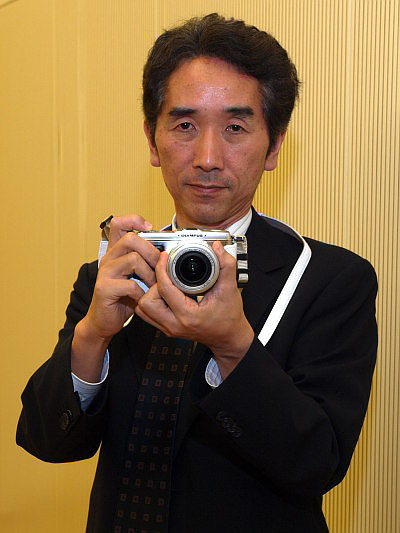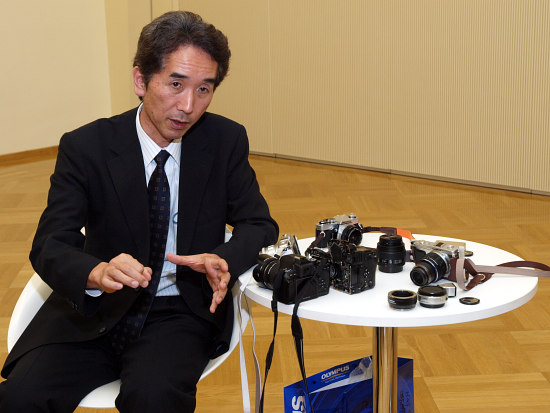Interview with Akira Watanabe Manager - the main Olympus E-P1 designer
1. Interview with Akira Watanabe Manager, Digital SLR Product Strategy Department, Olympus Imaging Corporation
 |
Krzysztof Mularczyk: The 4/3 System first entered the scene in 1999. When did Olympus actually start developing the Micro 4/3?
Akira Watanabe:
We had an idea of designing a mirrorless system even before launching the 4/3 system.
But, the actual detailed design had been done together with Panasonic before the announcement of the Micro 4/3 last year.
Please Support UsIf you enjoy our reviews and articles, and you want us to continue our work please, support our website by donating through PayPal. The funds are going to be used for paying our editorial team, renting servers, and equipping our testing studio; only that way we will be able to continue providing you interesting content for free. |
- - - - - - - - - - - - - - - - - - - - - - - - - - - - - - - - - - - - - - - - - - - - - - - -
KM: What is the reason for the delay of Olympus Micro 4/3 cameras actually going on sale? Is it
connected with some marketing plans, or technological problems?
AW: After the announcement of the Micro 4/3 system in last July, we launched the E-30, the E-450 and the E-620 before the E-P1. Some small components, like the new Image Stabilization unit, were newly developed to be commonly used by the E-620 and the E-P1. So, the development of new components took time and we put priority on the launching of the 4/3 models.
KM:
When will the Olympus Micro 4/3 appear on the market? What will happen
to the E-4xx/E-5xx amateur models? Will they continue to be developed?
AW: It will be on the market in early July. For details, please ask our European colleagues. For future models we can not disclose the plan at the moment.
KM: How will the Micro 4/3 deal with problems like the digital rangefinder that plagued the Leica M8 (i.e., not enough space for an infrared filter and telecentricity of the lenses)?
AW: As the 4/3 system and the Micro 4/3 system are designed for digital from the ground up, there is no problem that other film based systems have. We secured enough space for the optical filters required for the digital system, and the telecentric design is perfectly kept for the both systems.
KM: Regarding image stabilization in Micro 4/3 cameras, Is it possible to create a very small camera with the same high quality stabilisation system like the E-3?
AW: The OLYMPUS PEN E-P1 incorporates a newly developed downsized IS unit. Same as in 620 – which already proved its efficiency.
Is this answering your question?
KM: The latest Olympus DSLRs have ''Art filters''. Will these functions
be further developed? Are you planning to create more similar opportunities in
this user niche than other companies?
AW: We have many future candidates for the "Art Filters". We chose the top 6 filters that we thought best for our customers, and also preparing other filters to be incorporated in the future models.
We think this feature will be one of the key points for our system and will keep on intensively developing new ones. Last but not least we offer HD movie with art filters which we think is a nice option for our customers and makes the camera different from competition.
KM: Olympus has declared an end to the megapixel race. Does it mean we
will have 12 MPix in Micro 4/3 for a long time? Is there any chances we will see a lower
megapixel range? A matrix with 8-10 MPix could improve dynamic range,
reduce noise, increase speed and increase sensitivity. Who decides
on the amount of pixels?
AW: I have not said we will stop the pixel race nor stop at 12M, but I think pixel count is now less important than before, since we have already exceeded 10M pixels and satisfying most of the applications in terms of resolution that normal customers require.
We can not disclose what kind of sensors we are developing, but will try to keep on improving them to meet customers' demands.
KM: A question concerning the roadmap for lens development. How many lenses for the
Micro 4/3 will we see in the next 1-2 years?
AW: We are planning a wide zoom and a high-mag zoom next spring. For further plans, we would like to inform the customers when it becomes possible.
KM: Can we expect an increase in the number of fast fixed focal length lenses in the near future?
AW: Let us take that as a request.
KM: The System 4/3 doesn’t have an ultrawide zoom like 16-35 f/2.8 on FF. In the
Micro 4/3 is it easier or harder to develop this type of lens?
AW: We have 7-14mm zoom which is equivelent to 14-28mm in 35mm film format in our 4/3 system.
Comparing the 4/3 system and the Micro 4/3 system, generally speaking, the Micro 4/3 would be able to make a wide lenses smaller because of its shorter flange back.
KM: And the last questions about lenses. How many ''pancakes'' in Micro
4/3 can be expected in the near future? Will we see them also in normal
4/3 systems?
AW: As to the lenses, what we can disclose at the moment are the above mentioned two zoom lenses in next spring, and we are also planning a firmware upgrade of the 12-60 mm and the 50-200 mm SWD to be capable of the high speed imager AF.
KM: The new E-620 is certainly of interest to tourists. It is a light and
compact camera. Can we expect a similar, but more durable and tough
version with dust and waterproof body?
AW: Let me take it as a request.
KM: In conclusion, I’d like to ask about the Pro DSLR market and a future successor to the E-3.
Is Olympus planning two different versions of the E-3, something like the Nikon D3 and D3x or Canon 1D and 1Ds? The studio version of the E-3 could have 12 MPix or more and
low sensitivity from ISO 25 to ISO 200-400, while the reporter version E-3 could
be faster, have 8-10 MPix and higher sensitivity starting from ISO 200.
In this scenario, both cameras would have the optimum combination of quantity of
pixels, dynamic range and noise. Is it too risky for Olympus to create
such a solution? Or maybe there are some technological problems?
AW: With the E-3 and the E-30, while the basic performance is the same for both, we wanted to offer reliability and durability with the E-3 and the creativity with the E-30. For future models, we will take the customers' advice and develop what we think is best for them. Thank you for your advice.
KM: Thank you for the interview.
 |






